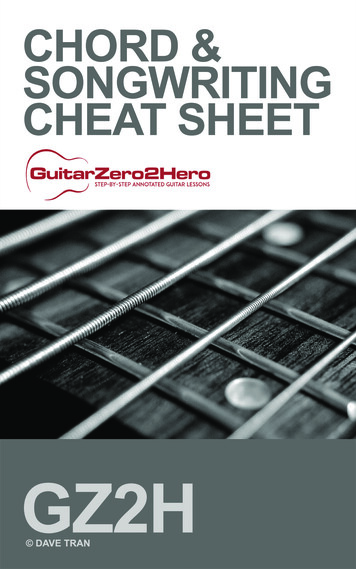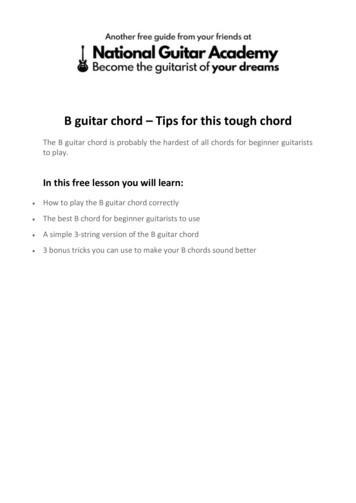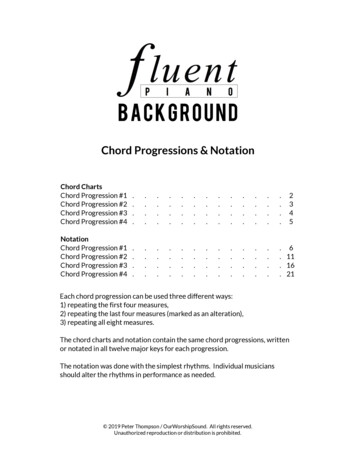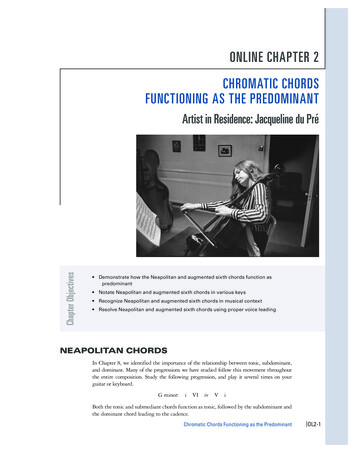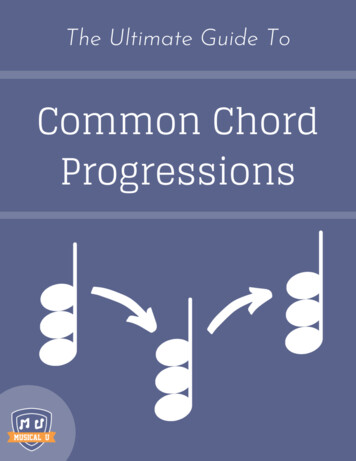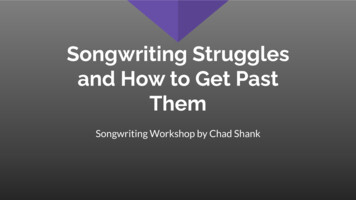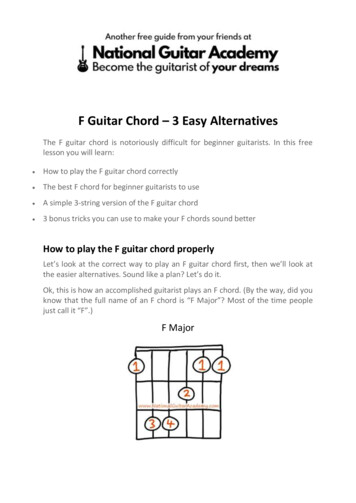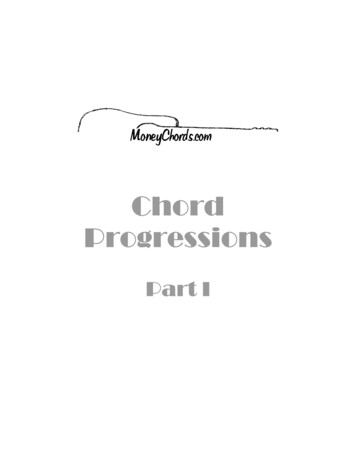
Transcription
ChordProgressionsPart I
2Chord ProgressionsThe Best Free Chord Progression Lessons on the Web"The recipe for music is part melody, lyric, rhythm, and harmony (chord progressions). The termchord progression refers to a succession of tones or chords played in a particular order for aspecified duration that harmonizes with the melody. Except for styles such as rap and free jazz,chord progressions are an essential building block of contemporary western music establishingthe basic framework of a song. If you take a look at a large number of popular songs, you will findthat certain combinations of chords are used repeatedly because the individual chords just simplysound good together. I call these popular chord progressions the money chords. These moneychord patterns vary in length from one- or two-chord progressions to sequences lasting for thewhole song such as the twelve-bar blues and thirty-two bar rhythm changes." (Excerpt fromChord Progressions For Songwriters 2003 by Richard J. Scott) Every guitarist should have aworking knowledge of how these chord progressions are created and used in popular music.Click below for the best in free chord progressions lessons available on the web.Ascending Augmented (I-I -I6-I7) - - 4Ascending Bass Lines - - 5Basic Progressions (I-IV) - - 10Basie Blues Changes - - 8Blues Progressions (I-IV-I-V-I) - - 15Blues With A Bridge - - 36Bridge Progressions - - 37Cadences - - 50Canons - - 44Circle Progressions -- 53Classic Rock Progressions (I-bVII-IV) -- 74Coltrane Changes -- 67Combination Progressions -- 79Counterpoint -- 81Descending Bass Lines -- 76Descending Minor Cliche -- 94Diminished Cliche (I-#Io-ii-V) -- 95Doo-Wop Progressions (I-vi-IV-V) -- 97
3Eight-Bar Blues Progressions (I-IV-I-V-I)EndingsFlamenco Progressions (i-bVII-bVI-V)Folk Progressions (I-V)General Chord Progression LessonsGospel ProgressionIntroductionsJazz Progressions (ii-V-I)La FoliaMinor Blues Progressions (i-iv-i-v-i)ModulationOne-Chord Progressions (I / i)Parker Blues ChangesPedal PointsPop-Rock Lydian II Progressions (I-II-IV-I)Precadential Progressions pdfRagtime Progressions (I-VI7-II7-V7)Relative Minor VampsRhythm ChangesRock and Roll Progressions (I-IV-V)Rock Ballad (I-iii-IV-V)Sixteen-Bar Blues Progressions (I-IV-I-V-I)Standard Progressions (I-vi-ii-V)SubstitutionTurnaroundsTwenty-Four Bar Blues Progressions (I-IV-I-V-I)VampsCopyright 2006 MoneyChords.com
4Ascending Augmented Progressions(I-I -I6-I7)"Inserting the "C " (common tone substitution), the "C6" (embellishment), and the "C7" (chordquality change) in the "C" one-chord progression creates the "C-C -C6-C7" ascendingaugmented propression a shown below.One-chord progression: C / C / C / C / Ascending Augmented: C / C / C6 / C7 / An example of this type of pedal point is the opening verse progression to Whitney Houston's1986 hit The Greatest Love Of All.The box below shows other examples of this type of pedal point. Notice that the "C-C -C6-C "pedal point has a middle voice line that moves both up and down. The "C-C -C6" and "C-C "examples are further variations (omitted chords) of this type of pedal point." (Excerpt from ChordProgressions For Songwriters 2003 by Richard J. Scott)C C C6 C7(You've Got To) Accentuate The Positive chorus (Standard - 1944),Because verse (Dave Clark Five - 1964), Laughing verse (Guess Who 1969), Love Will Keep Us Together chorus (Captain & Tennille - 1975),and Stand Tall verse (Burton Cummings - 1976)C C C6 C9Maybe This Time verse (from "Cabaret" - 1966) and Losing My Mindverse (from "Follies" – 1971)C C C6 C Louise A section (from "Innocents Of Paris" - 1929), Match Maker Asection (Standard - 1964), and (Just Like) Starting Over verse (JohnLennon - 1980)C C C6 C#o7 For Once In My Life verse (Stevie Wonder - 1968)C C --Baby Hold On To Me verse (Eddie Money - 1978)Guitarists should be able to easily play typical ascending augmented progression chord changesin the most commonly used keys. Below are the chord fingerings I like for various ascendingaugmented progressions.Laughing verse:A x07655 A x07665 A6 x07675 A7 x07685Dmaj7 xx0675 Dm7 xx0565 C#m7 x46454 E 022100The Greatest Love Of All verse:E 022100 E 03211x E6 02x12x E7 02x13xA x0222x A x0322x A6 x0422x A x0322x
5Stand Tall verse:G 3x0003 G 3x1003 G6 3x2003 G7 3x3003Cmaj7 x32000 Cm x35543 G 320003 C 032010Maybe This Time verse:C x32010 C x3211x C6 x3221x C9 x32330F xx3211 F xx3221 Dm xx0231 F#o7 xx1212As with learning any new progression, you should study it by playing it in all twelve keys. Also, trysubstituting the ascending augmented progression where a “I” chord is used for two or more bars.Ascending Bass LinesAscending bass line progressions are a type of moving bass line progression where the bassnotes of each chord in the progression move higher typically following the "1-2-3-4," "2-3-4-5," "12-4-5", or "1-3-4-5," "1-#1-2-#2," "1-#1-2-5," and "1-2-b3-3" note bass lines. Ascending bass lineprogressions are popular with songwriters wishing to create a bright sound. Scott Joplin and otherRagtime writers frequently used the "IV-#IVo-V7" progression to brighten their songs. Some greatpopular music of the last century has been written around ascending bass line progressions suchas Ain't She Sweet (1927), Ain't Misbehavin' (1929), Stormy Weather (1933), Oh What ABeautiful Morning (1943), I'm Gonna Wash That Man Right Outa My Hair (1949), Like A RollingStone (1965), As Tears Go By (1966), I'm Not Your Steppin' Stone (1967), Love Is All Around(1968), Bend Me Shape Me (1968), Lean On Me (1972), Live And Let Die (1973), Slow Dancin'(1977), With A Little Luck (1978), My Life (1979), Key Largo (1982), Have I Told You Lately(1989), and Heart Of The Matter (1990). Three great examples of ascending bass lines areshown below in the key of C.Ain't Misbehavin' (Fats Waller - 1929) opening A section progression[1-#1-2-#2 chromatic pattern]C / C#o7 /Dm7 / D#o7 /C/E / E7#5 /F6 / Fm6 /Like A Rolling Stone (Bob Dylan - 1965) opening verse progression[1-2-3-4-5 diatonic pattern]C / Dm /Em / F /G///////Somewhere Out There (Linda Ronstadt & James Ingram - 1987) opening verse progression[1-3-4-5 diatonic pattern]Cadd9 / Cmaj7/E /Fmaj7 / G11 /
6Click below for the best in free Ascending Bass Lines lessons available on the web as well aslinks to various song examples.LessonsAscending Augmented I-I -I6-I7 Progressions (MoneyChords)Chord Stream - I-ii-iii Progression (Olav Torvund)Chord Stream - I-ii-iii-IV Progression (Olav Torvund)The "Creep" Chord Progression (PSR Tutorial)Diminished Cliche I-#Io-IV-V Progressions (MoneyChords)Rock Ballad I-iii-IV-V Progressions (MoneyChords)Song ExamplesAin't Misbehavin' (MoneyChords)Don't Get Around Much Anymore (MoneyChords)Hotel California (MoneyChords)Like A Rolling Stone (MoneyChords)Ain't Misbehavin'Here are the chord substitutions that I use to play the 1929 Fats Waller (pictured above) standardAin't Misbehavin'. The verse is a great study in standard (I-vi-ii-V) chord progression substitution.In my arrangement, the opening progression has a great ascending chromatic bass line. Eachbox below represents one bar. The chord fingerings I use (in a Standard tuning) are as follows:Emaj7 022444; Fo7 1x010x; F#m7 2x2222; Go7 3x232x; E/G# 4x245x; G#7#5 4x455x; A6 5x465x; Am6 5x4555; G7 3x34xx; B7b5/F 1x120x; G#7 464544; C#7 x4342x; F#7 242322; B7 x2120x; C#m x46654; A9 5x5600; B x2444x; Co7 x3x242;C#m7 x46454. For variation, try substituting the "C#7" chord for the "G7" chord in the fifth bar ofthe A section. Also, try substituting the "Emaj7/G#-Go7-F#m7-Fo7" or "Emaj-C#7-F#m9-B13"progressions for the seventh and eighth bars of the A Section.A sectionEmaj7 / Fo7 /F#m7 / Go7 /E/G# / G#7#5 /A6 / Am6 /E/G# / G7 /F#m7 / B7b5/F /G#7 / C#7 /F#7 / B7 /
7B sectionC#m / / /A9 / / /C#m / / /C#7 / / /B / Co7 /C#m7 / F#7 /B7 / C#7 /F#7 / B7 /Don't Get Around Much AnymoreHere are the chord substitutions that I use to play the 1942 Duke Ellington standard Don't GetAround Much Anymore. The A section of the song is creatively written around a ragtimeprogression. In my arrangement, the opening progression has a great ascending chromatic bassline. I play the tune in a moderate 4/4 tempo in the key of "E". Each box below represents onebar. The chord fingerings I use (in a Standard tuning) are as follows: Emaj7 022444; F#m7 242222; Go7 3x232x; Emaj7/G# 4x244x; C#7 x4342x; F#7 242322; B7 x21202; Bm7 7x7777; E7/A# 6x675x; Amaj7 5x665x; A#o7 6x565x; G#m7 4x4444; C#7/G 3x342x;and B7/F 1x120x. For variation, try connecting the "EM7/G#" and the "C#7" chords in thesecond and third bars of the A section with an "E7-D#7-D7-C#7" walk down.A sectionEmaj7 F#m7 Go7 Emaj7/G#Emaj7/G# / / /C#7 / / /////F#7 / / /B7 / / /Emaj7 / / /F#m7 / B7 /A sectionEmaj7 F#m7 Go7 Emaj7/G#Emaj7/G# / / /C#7 / / /////F#7 / / /B7 / / /Emaj7 / / /Bm7 / E7/A# /B sectionAmaj7 / / /A#o7 / / /Emaj7 / / /Bm7 / E7/A# /Amaj7 / / /A#o7 / / /G#m7 / C#7/G /F#m7 / B7/F /
8Hotel CaliforniaHere are the unplugged chords that I use to play the Eagles' 1977 number-one hit HotelCalifornia. The verse is one of the great minor progression studies around. The opening verseprogression to this song uses a minor folk progression (Im-V). In this arrangement, I have addeda descending bass line to the verse and an ascending bass line to the chorus. The Eagles'(pictured above) recording uses a twelve- string guitar capoed at the seventh fret using thefollowing open position chords: Verse Em-B7-Dsus2-A9/C#-C-G-Am7-B7 and Chorus C-GB7-Em-C-G-Am-B7. The chord fingerings I use (in a Standard tuning) are as follows: Am x02210; E7/G# 4x0430; Gsus2 3x020x; D9/F# 2x0210; F 133211; C/E 032010; Dm7 xx0211; E7/B x20100; C/G 332010; and Dm/A x00231.VerseAm / / /E7/G# / / /Gsus2 / / /D9/F# / / /F///C/E / / /Dm7 / / /E7/B / / /ChorusF///C/G / / /E7/G# / / /Am / / /F///C/G / / /Dm/A / / /E7/B / / /Like A Rolling StoneHere are the unplugged chords that I use to play Bob Dylan's 1965 hit Like A Rolling Stone. Theoriginal song and my arrangement are in the original key of C. I play the song in a moderate 4/4rock tempo. The root notes of the opening "C-Dm-Em-F-G" verse progression form a "1-2-3-4-5"ascending diatonic bass line creating an extended chord stream. Chord streams arecharacterized by sliding stepwise root movement from chord to chord climbing the harmonizedscale. In bars 13 through 16, the chord stream is reverse to create a contrasting descending bassline progression. The chorus is created by simply repeating the "I-IV-V" rock and roll progression.The chord fingerings I use (in a Standard tuning) are as follows: C x32010; Fmaj7/C x33210;Dm xx0231; Em 022000; F 133211; and G 320033.Intro (repeat 2x)C / Fmaj7/C /C / Fmaj7/C /
9VerseC / Dm /Em / F /G///////C / Dm /Em / F /G///////F///G///F///G///F / Em /Dm / C /F / Em /Dm / C /Dm / / /C/F/G///C/F/G///G///Chorus RiffCFGe------------------- --3--3--3--3-- B--1---1------------ --3--3--3--3-- G--0---0---2--0--2-- --0--0--0--0-- D--2---2---3-----3-- --0--0--0--0-- A--3---3---3-----3-- --2--2--2--2-- E------------------- --3--3--3--3--
10Basic Progressions(I-IV)"The repeated “E-A” Basic Progression, which follows the Circle Of Fifths movement, is one ofthe least complex and most popular changes in all popular music with numerous examples foundthroughout the twentieth century. Keith Richards of the Rolling Stones has made millions ofdollars over the years writing and playing hard rock songs with these two basic chords played onan open G tuned electric guitar. Examples of hit songs created around the Basic Progressioninclude the Beatles’ 1964 Love Me Do, John Denver’s 1974 number one Sunshine On MyShoulders, and Bruce Springsteen’s 1985 Glory Days." (Excerpt from Money Chords - ASongwriter's Sourcebook of Popular Chord Progressions 2000 by Richard J. Scott) Three greatexamples of basic progressions are shown below in the key of C.Midnigt Hour (Wilson Pickett - 1965) verse progression C/F/ C/F/ Glory Days (Bruce Springsteen - 1985) verse progression C/// F/// C/// F/// Once Bitten Twice Shy (Greay White - 1989) chorus progression C/// //// F/// //// Click below for the best in free Basic Progression lessons available on the web as well as links tovarious song examples.LessonsThe I-IV Change (Olav Torvund)Songs With The I-IV Progression (Olav Torvund)I-ii Progressions (Olav Torvund)Song ExamplesImagine (MoneyChords)I Still Haven't Found What I'm Looking For (MoneyChords)Leaving, On A Jet Plane (MoneyChords)Tiny Dancer (MoneyChords)
11ImagineHere are the unplugged chords that I use to play John Lennon's 1971 hit song Imagine. This songwas written and recorded on piano. Keep this in mind when playing it on your guitar. The chordsare shown in the original key of C. The A section is built around a "I-IV" basic progression with anembellished "I" chord in the middle. Check out the "4-3-2-1" diatonic descending bass line figurein bars 1 and 2 of the B section. You can also create an ascending bass line by playing the Ebass note on the Cma7 chord ("C-Cmaj7/E-F"). You can mix it up if you like.The main piano riff is shown below.CCmaj7FE-------------- -------------------- B--1--1--1--0-- --1--1--1--------0-- G--0--0--0--0-- --2--2--2--2--3----- D--2--2--2--2-- --3--3--3----------- A--3--3--3--3-- --3--3--3----------- E--3--3--3--3-- --1--1--1----------- The chord fingerings I use (in a Standard tuning) are as follows: C 332010; Cmaj7 332000; F 133211; Am/E 002210; Dm7 xx0122; F/C x33211; G 3x0003; C/G 3x2010; G7 353433; E 0220100; and E7 020100.A sectionC / / Cmaj7F///C / / Cmaj7F///C / / Cmaj7F///C / / Cmaj7F///B sectionF / Am/E /Dm7 / F/C /G / C/G /G7 / / /C sectionF/G/C Cmaj7 E E7F/G/C Cmaj7 E E7F/G/C Cmaj7 E E7F/G/C///
12I Still Haven't Found What I'm Looking ForHere are the unplugged chords that I use to play U2's 1987 hit I Still Haven't Found WhatI'm Looking For . The verse is written around a "I-IV-I" basic progression with doublesoprano pedal points. The chorus is comprised of repeated "V-IV-I" rock and rolldisplacement progressions. The song is played moderately with a steady beat in 4/4 time.The chord fingerings I use (in a Standard tuning) are as follows: E5 079900; Asus2 577600; and Bsus4 799800.Verse E5 chord patternE--0--0--0--0--0--0--0--0-- --0--0--0--0--0--0--0--0-- B--0--0--0--0--0--0--0--0-- --0--0--0--0--0--0--0--0-- G--8--9--9--9--9--9--9--9-- --8--9--9--9--9--9--9--9-- D--9--9--9--9--9--9--9--9-- --9--9--9--9--9--9--9--9-- A--7--7--7--7--7--7--7--7-- --7--7--7--7--7--7--7--7-- E--0--0--0--0--0--0--0--0-- --0--0--0--0--0--0--0--0-- VerseE5 / / /////////////Asus2 / / /////E5 / / /////E5 / / /////////////Asus2 / / /////E5 / / /////ChorusBsus4 / / /Asus2 / / /E5 / / /////Bsus4 / / /Asus2 / / /E5 / / /////
13Leaving, On A Jet PlaneHere are the unplugged chords that I use to play Peter, Paul and Mary's 1969 hit Leaving, On AJet Plane . The verse is written around a "Imaj7-IIm" tonic pedal point. The chorus is comprised ofrepeated "I-IV" basic progressions. The song is played moderately in 4/4 time. The chordfingerings I use (in a Standard tuning) are as follows: Emaj7 022444; F#m7/E 0x2222; C#m x46654, A 577655; and B x2444x; B7 x21202; G#m 466444; F#m x244222. To playalong with the record, transpose these changes in the key of E to the key of A. The "Amaj7" chordis fingered as x06654 and the "Bm7/A" is played as x04432.IntroEmaj7 / / /F#m7/E / / /B///B7 / / /A///E///VerseEmaj7 / / /F#m7/E / / /Emaj7 / / /F#m7/E / / /Emaj7 / / /C#m / / /B///B7 / / /Emaj7 / / /F#m7/E / / /Emaj7 / / /F#m7/E / / /Emaj7 / / /C#m / / /B///B7 / / /ChorusE///A///E///A///E///C#m / / /B///B7 / / /E///A///E///A///E///G#m / / /F#m / / /B///
14Tiny DancerHere are the unplugged chords that I use to play Elton John's 1971 hit Tiny Dancer. The verse iswritten around a "C-F/C" basic progression with a tonic pedal point. The song is playedmoderately slow 4/4 tempo. The chord fingerings I use (in a Standard tuning) are as follows: C x32010; F/C x33211; F/A x03211; G/B x3003x; G6 3x0000; F 133211; Em7 020000;Am7 x02010; D/F# 2x023x; Dm7 xx0211; E7 020100; G 320003; C/E 032010; Dm7 x00211; Ab 466544; Bb x1333x; Gm 355333; Cm x35543; G7/B x2300x; G7/D x00001; Dm xx0213; Em 022000; and G6/A x05430.Intro (repeat 4x)CF/Ce-----------0----------------------- B--------1-----3--1--------------1-- G-----0-----------2--2--------2----- D--2--------------3--------3-------- A--3--------------3-----3----------- E----------------------------------- VerseC / F/C /C / F/C /C///F/A / / [G/B]C / F/C /C / F/C /C///F/A / / [G6]F / Em7 /Am7 / D/F# /Dm7 / E7 /Am7 / G /C / F/C /C / F/C /C///G F C/E Dm7C / F/C /C / F/C /BridgeAb / Bb /Gm / Cm /G7/B / / /G7/D / / /Ab / / /Bb / / /ChorusF / C/E /Dm / / [Em]F / C/E /G6/A / / /F / C/E /Dm / / [Em]F / C/E /G6/A / / /
15Basie Blues ChangesAs the Blues form evolved during the Swing Era, the V-IV-I cadence in bars 9through 12 was replaced by the ii-V-I Jazz Progression. The Count BasieOrchestra played many blues-oriented compositions during this time period. Thisprogression was used in tunes such as their popular One O'Clock Jump Below isan example of the Basie Blues Changes in the key of C.C7 / / /F7 / F#o7 /C7 / / /Gm7 / C7 /F7 / / /F#o7 / / /C7 / / /A7 / / /Dm7 / / /G7 / / /C7 / / /C7 / / /Click below for the best in free Basie Blues Changes lessons available on theweb as well as links to various examples.LessonsBasie Blues (VT Music Dictionary)Blues Chord Progressions & Variations (JazzGuitar.be)The Evolution of the 12 Bar Blues Progression (Bob Brozman)
16Song ExamplesBasie Blues for Band-In-A BoxBasie Blues ChartOne O'Clock Jump
17Blues ProgressionsThe blues is a vocal and instrumental form of music based on a pentatonic scale and acharacteristic twelve-bar chord progression. The form evolved in the United States in thecommunities of former African slaves from spirituals, praise songs, field hollers, shouts, andchants. The use of blue notes and the prominence of call-and-response patterns in the music andlyrics are indicative of the blues' West African pedigree. The blues has been a major influence onlater American and Western popular music, finding expression in ragtime, jazz, bluegrass, rhythmand blues, rock and roll, hip-hop, and country music, as well as conventional pop songs.The phrase the blues is a synonym for having a fit of the blue devils, meaning low spirits,depression and sadness. An early reference to this can be found in George Colman's farce Bluedevils, a farce in one act (1798). Later during the 19th century, the phrase was used as aeuphemism for delirium tremens and the police. Though usage of the phrase in African Americanmusic may be older, it has been attested to since 1912 in Memphis, Tennessee with W. C.Handy's "Memphis Blues." In lyrics the phrase is often used to describe a depressed mood.OriginsThere are few characteristics common to all blues, because the genre takes its shape from thepeculiarities of individual performances. However, some characteristics have been present sincebefore the creation of the modern blues and are common to most styles of African Americanmusic. The earliest blues-like music was a "functional expression, rendered in a call-andresponse style without accompaniment or harmony and unbounded by the formality of anyparticular musical structure." This pre-blues music was adapted from slave field shouts andhollers, expanded into "simple solo songs laden with emotional content". The blues, as it is nowknown, can be seen as a musical style based on both European harmonic structure and the WestAfrican call-and-response tradition, transformed into an interplay of voice and guitar.Many blues elements, such as the call-and-response format and the use of blue notes, can betraced back to the music of Africa. Sylviane Diouf has pointed to several specific traits—such asthe use of melisma and a wavy, nasal intonation—that suggest a connection between the musicof West and Central Africa and blues Ethnomusicologist Gerhard Kubik may have been the first tocontend that certain elements of the blues have African roots. For instance, Kubik pointed out thatthe Mississippi technique of playing the guitar using a knife blade, recorded by W.C. Handy in hisautobiography, is common to West and Central Africa cultures where the kora, a guitar-likeinstrument, is often the stringed instrument of choice. This technique consists of pressing a knifeagainst the strings of the guitar, and is a possible antecedent of the slide guitar technique.Blues music later adopted elements from the "Ethiopian airs"—"Ethiopian" is used here to meanblack"—of minstrel shows and Negro spirituals, including instrumental and harmonicaccompaniment. The style also was closely related to ragtime, which developed at about thesame time, though the blues better preserved "the original melodic patterns of African music".Songs from this early period had many different structures. Examples can be found in Leadbelly'sor Henry Thomas's recordings. However, the twelve-, eight-, or sixteen-bar structure based ontonic, subdominant and dominant chords became the most common. What is now recognizableas the standard 12-bar blues form is documented from and appearing in African Americancommunities throughout the region along the lower Mississippi River during the first decade of the1900s (and performed by white bands in New Orleans at least since 1908). One of these earlysites of blues evolution was along Beale Street in Memphis, Tennessee.Lyrics
18Early blues frequently took the form of a loose narrative, often with the singer voicing his or her"personal woes in a world of harsh reality: a lost love, the cruelty of police officers, oppression atthe hands of white folk, hard times". Many of the oldest blues records contain gritty, realisticlyrics, in contrast to much of the music being recorded at the time. One of the more extremeexamples, "Down in the Alley" by Memphis Minnie, is about a prostitute having sex with men inan alley. Music such as this was called "gut-bucket" blues. The term refers to a type ofhomemade bass instrument made from a metal bucket used to clean pig intestines forchitterlings, a soul food dish associated with slavery and deprivation. "Gut-bucket" describedblues that was "low-down" and earthy, that dealt with often rocky or steamy man-womanrelationships, hard luck and hard times. Gut-bucket blues and the rowdy juke-joint venues whereit often was played, earned blues music an unsavory reputation. Upstanding church-going peopleshunned it, and some preachers railed against it as sinful. And because it often treated thehardships and injustices of life, the blues gained an association in some quarters with misery andoppression. But the blues was about more than hard times; it could be humorous and raunchy aswell:Rebecca, Rebecca, get your big legs off of me,Rebecca, Rebecca, get your big legs off of me,It may be sending you baby, but it's worrying the hell out of me.Author Ed Morales has claimed that Yoruba mythology played a part in early blues, citing RobertJohnson's "Crossroads" as a "thinly veiled reference to Eleggua, the orisha in charge of thecrossroads". However, many seminal blues artists such as Joshua White, Son House, SkipJames, or Reverend Gary Davis were influenced by Christianity.The original lyrical form of the blues was probably a single line, repeated three times. It was onlylater that the current, most common structure—a line, repeated once and then followed by asingle line conclusion—became standard.Musical styleThough during the first decades of the twentieth century blues music was not clearly defined interms of chords progression, the twelve-bar blues became standard in the '30s. However, inaddition to the conventional twelve-bar blues, there are many blues in 8-bar form, such as "HowLong Blues", "Trouble in Mind", and Big Bill Broonzy's "Key to the Highway". There are also 16bar blues, as in Ray Charles's instrumental "Sweet 16 Bars". The basic twelve-bar lyricframework of a blues composition is reflected by a standard harmonic progression of twelve bars,in 4/4 or 2/4 time. The blues chords associated to a twelve-bar blues are typically a set of threedifferent chords played over a twelve-bar scheme:IIVVI or IVIVIVIIIIII or Vwhere the Roman numbers refer to the degrees of the progression. That would mean, if played inthe tonality of F, the chords would be as follows:FBbCF orBbBbBbFFFFFF or C
19In this example, F is the subdominant. Note that much of the time, every chord is played in thedominant seventh (7th) form. Frequently, the last chord is the dominant (V or in this case C)turnaround making the transition to the beginning of the next progression.The lyrics generally end on the last beat of the tenth bar or the first beat of the eleventh bar, andthe final two bars are given to the instrumentalist as a break; the harmony of this two-bar break,the turnaround, can be extremely complex, sometimes consisting of single notes that defyanalysis in terms of chords. The final beat, however, is almost always strongly grounded in thedominant seventh (V7), to provide tension for the next verse. Musicians sometimes refer totwelve-bar blues as "B-flat" blues because it is the traditional pitch of the tenor sax,trumpet/cornet, clarinet and trombone.Melodically, blues music is marked by the use of the flatted third, fifth and seventh (the so-calledblue or bent notes) of the associated major scale. While the twelve-bar harmonic progression hadbeen intermittently used for centuries, the revolutionary aspect of blues was the frequent use ofthe flatted fourth, flatted seventh, and even flatted fifth in the melody, together with crushing—playing directly adjacent notes at the same time, i.e., diminished second—and sliding—similar tousing grace notes. Where a classical musician will generally play a grace note distinctly, a bluessinger or harmonica player will glissando; a pianist or guitarist might crush the two notes and thenrelease the grace note. Blues harmonies also use the subdominant major-minor seventh and thetonic major-minor seventh in place of the tonic. Blues is occasionally played in a minor key. Thescale differs little from the traditional minor, except for the occasional use of a flatted fifth in thetonic, often crushed by the singer or lead instrument with the perfect fifth in the harmony. JanisJoplin's rendition of "Ball and Chain", accompanied by Big Brother and the Holding Company,provides an example of this technique. Also, minor-key blues is most often structured in sixteenbars rather than twelve—e.g., "St. James Infirmary Blues" and Trixie Smith's "My Man RocksMe"—and was often influenced by evangelical religious music.Blues shuffles are also typical of the style. Their use reinforces the rhythm and call-and-responsetrance, the groove. Their simplest version commonly used in many postwar electric blues, rockand-rolls, or early bebops is a basic three-note riff on the bass strings of the guitar. Played in timewith the bass and the drums, this technique, similar to the walking bass, produces the groove feelcharacteristic of the blues. The last bar of the chord progression is usually accompanied by aturnaround making the transition to the beginning next progression. Shuffle rhythm is oftenvocalized as "dow, da dow, da dow, da" or "dump, da dump, da dump, da" as it consists ofuneven eight notes. On a guitar this may be done as a simple steady bass or may add to thatstepwise quarter note motion from the fifth to the seventh of the chord and back. An example isprovided by the following tablature for the first four bars of a blues progression in E:EBGDAEE7A7E7E7 ------------------- ------------------- ------------------- ------------------- ------------------- ------------------- ------------------- ------------------- ------------------- ------------------- ------------------- ------------------- ------------------- 2--2-4--4-2--2-4--4 ------------------- ------------------- 2--2-4--4-2--2-4--4 0--0-0--0-0--0-0--0 2--2-4--4-2--2-4--4 2--2-4--4-2--2-4--4 0--0-0--0-0--0-0--0 ------------------- 0--0-0--0-0--0-0--0 0--0-0--0-0--0-0--0 OriginsBlues has evolved from the spare music of poor black laborers into a wide variety of complexstyles and subgenres, spawning regional variations across the United States and, later, Europe,Africa and elsewhere. What is now considered "blues" as well as modern "country music" aroseat approximately the same time and place during the nineteenth century in the southern UnitedStates. Recorded blues and country can be found from as far back as the 1920s, when thepopular record industry developed and created marketing categories called "race music" and"hillbilly music" to sell music by and for blacks and whites, respectively. At the time, there was noclear musical division between "blues" and "country," except for the race of the performer, and
20even that sometimes was documented incorrectly by record companies. While blues emergedfrom the culture of African-Americans, blues musicians have since emerged world-wide. Studieshave situated the origin of "black" spiritual music inside slaves' exposure to their masters'Hebridean-originated gospels. African-American economist and historian Thomas Sowell alsonotes that the southern, black, ex-slave population was acculturated to a considerable degree byand among their Scots-Irish "redneck" neighbors. However, the findings of Kubik and others alsoclearly attest to the essential Africanness of many essential aspects of blues expression.Much has been speculated about the social and economical reasons for the appearance of theblu
chord progressions are an essential building block of contemporary western music establishing the basic framework of a song. If you take a look at a large number of popular songs, you will find that certain combinations of chords are used repeatedly because the individual chords just simply sound good together. I call these popular chord .

